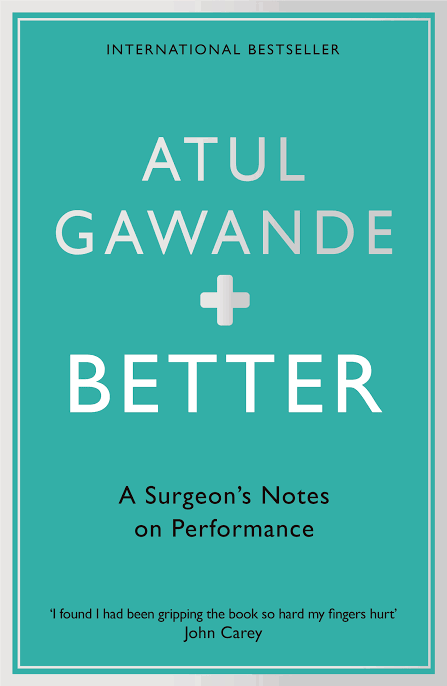“On Fighting”
The chapter discussed this week speaks volumes for itself. It has provided me with much reflection of my time volunteering at Oaklands school, where many of the children live fulfilling lives despite the challenges of their conditions. I encourage you to think about how this weeks topic is present in any of the areas you volunteer/work, or in your personal life. With that said, I hope you enjoy this weeks discussion.
Book of the week: Better: A Surgeon’s Notes on Performance by Atul Gawande
This week’s theme of doing right is the topic covered by Gawande in the second section of his book “Better.” The author draws upon 5 key stories, 1 of which will be covered this week:
“On fighting.” Gawande opens with a quote:
“I always used to think the hardest part of doctoring is learning the skills but it is not. It is also not the strain of the work. The hardest part of being a doctor is having an understanding of what you have power over and what you don’t.”
Highlighting this point, the author describes his treatment of a patient, Mr Thomas. Following the discovery of a 3-inch mass in his left kidney, Thomas underwent surgery to remove said kidney. Despite the surgery appearing to be successful initially, Thomas developed complications; he was bound to a wheelchair. Gawande reports telling Thomas that the only solution was to remove both adrenal glands. If Thomas did not go through with the operation, he would die in a matter of months. Gawande then asked the patient: “what are your hopes?” On hearing this, the patient responded: “I want to have a normal life, to be with my wife and to walk along the beach by my house again.” Although the surgery went as well as it could have, 7 months after the surgery Thomas had still not gotten home. With the patient’s ability to go home gone, so too were his hopes. This story serves as a reminder that:
“ although we have remarkable abilities granted to us by modern medicine, using them effectively is difficult, and understanding their limits is the most difficult task all.”
The author then goes on to criticize how many talk about the border of what can be done in medicine and what can’t as if it were a bright line. To further blurry this debate, analysts argue that the fact that in America a quarter of public health money is spent on the last 6 months of life; perhaps this spending could be spared? Gawande argues this line of reasoning ignores the absence of certainty in these situations and thus concludes that “we want doctors who fight.”
To add to this argument, Gawande recounts his conversations with a renowned professor of obstetrics. Discussing his proudest achievement, the professor recalls an experiment where they decided to treat babies born 2 months prematurely or more (at the time they were considered not worth treating) as if they would live no matter their condition. Doing this, they found the vast majority of these babies could survive to be healthy just by the doctors fighting for them.
This idea of fighting is continued by Gawande, with him utilising an ingenious analogy to illustrate his point:
“Think about on the battlefield, where soldiers are injured to extreme levels. We do not want doctors to leave them but to learn how to rehabilitate them. ”
The lesson is to always fight, always look for what more you can do. It helps avoid the biggest error of all, giving up on someone we could of helped.
On the other hand, at some points you have to admit that you are up against a problem you are unable to solve and by pushing harder you may be doing more harm than good. To illustrate this point, Gawande draws upon his consultation with a patient who presented with intense pain in the region of the body where the gallbladder is situated. Despite many tests, no anomalies relating to the gallbladder could be found, yet the patient still wanted to remove their gallbladder. Do you take out the gallbladder on the off chance it is the source?
Trying to find answers, the author recalls asking a nurse what she thought doctors should do. She said good doctors understand one key thing:
“This is not about them, it is about the patient. The good doctors didn’t always get the answer right but at least they stopped to wonder and consider what path they were on, and asked their colleagues for second opinions- they set aside their egos.”
Doing this is harder than it may seem. When someone comes to you for your expertise and your expertise has failed, what do you have left? You only have your character to fall back upon, and sometimes it is only your pride that comes through. Speaking from experience, Gawande argues that:
“In the end, no guidelines have the answers. In the face of uncertainty wisdom is on the side of pushing but you have to recognize when pushing is only ego, only weakness. You have to recognize when the pushing can turn to harm. Doctors do have the task to always fight but the fight is not always to do more but to do right by our patients, even when what is right is not always clear. ”
Figure 1- Front Cover of “Better”
Thanks for reading,
The Vansoh is a reader-supported publication. If you appreciate our work, consider becoming a free or paid subscriber.




